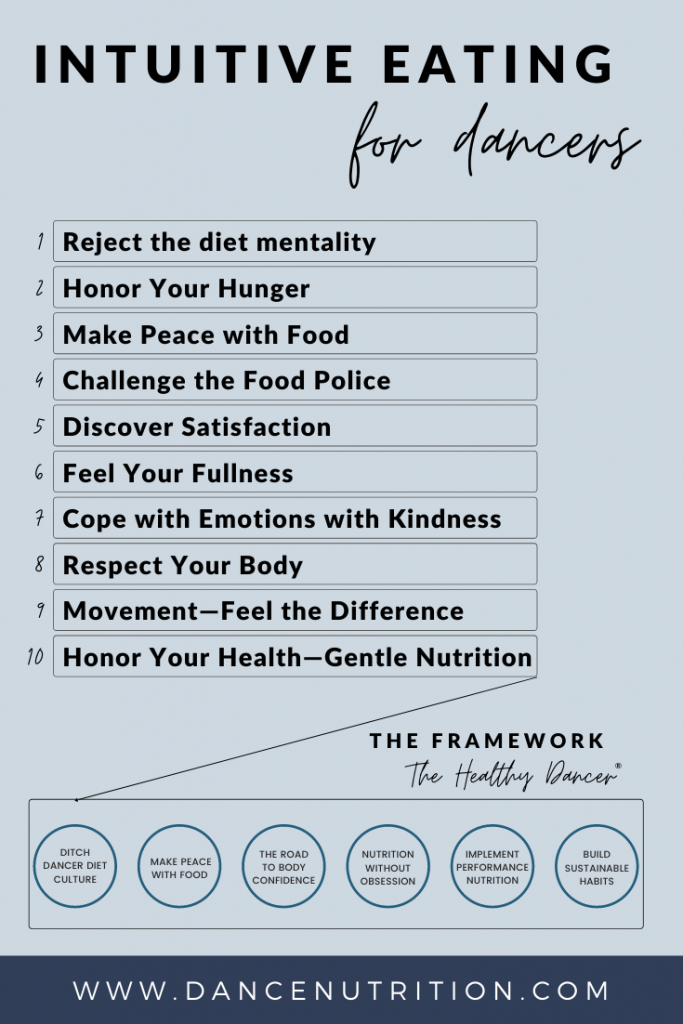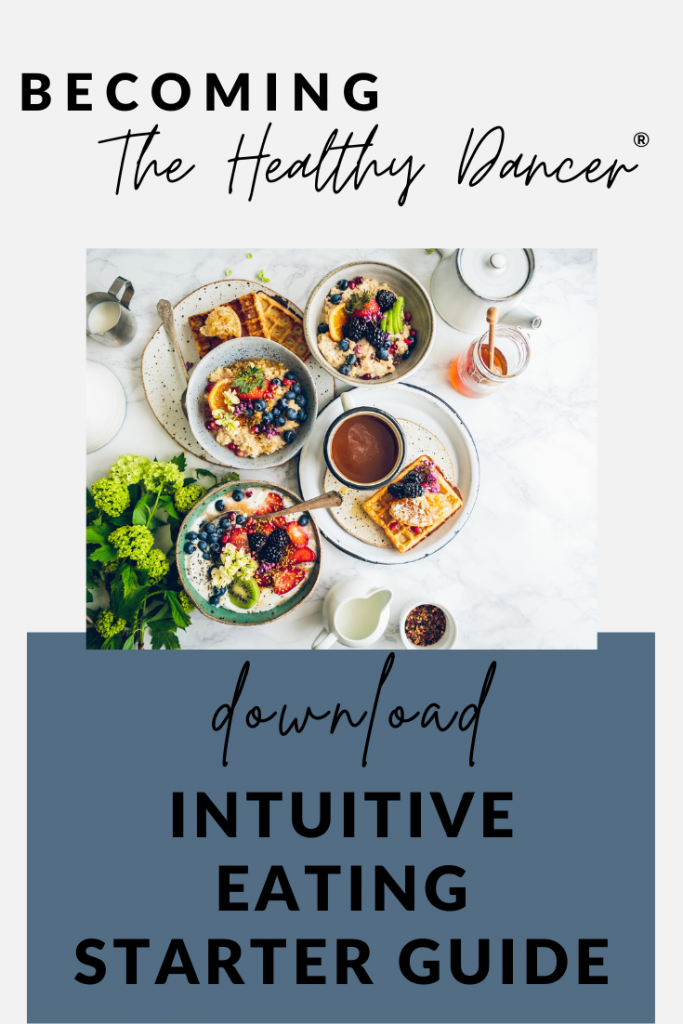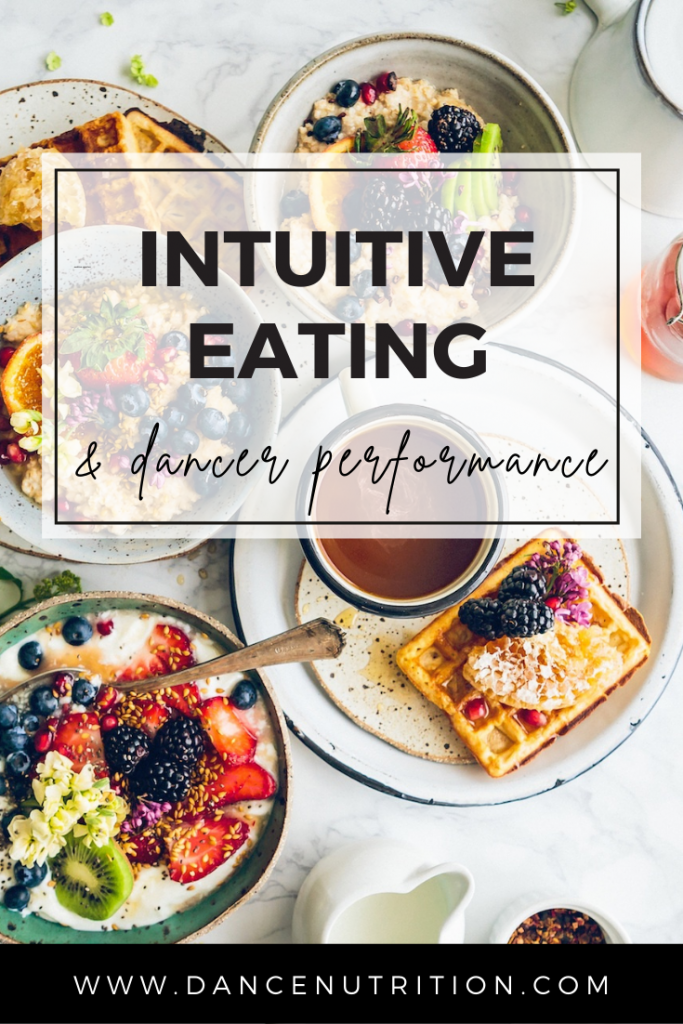
Food is more than just fuel—it’s a vital part of a dancer’s artistry, energy, and longevity. But in an industry saturated with harmful diet culture, knowing how to eat in a way that truly supports your body can feel confusing at best and overwhelming at worst.
As a multi-certified Registered Dietitian Nutritionist and Intuitive Eating Counselor for dancers, I’ve developed The Healthy Dancer® framework to help dancers nourish their bodies without sacrificing their mental health, creativity, or love for dance. This method uniquely integrates the science of performance-based eating with the principles of intuitive eating, allowing dancers to fuel sustainably, mindfully, and with joy.
In this post, I’ll explain what intuitive eating is, why it’s such a game-changer for dancers, and how you can begin your journey today. Be sure to scroll down for your free guide to get started.
What is Intuitive Eating?
Intuitive Eating is a lifestyle framework that dietitians Evelyn Tribole and Elyse Resch developed in 1995. Grounded in ten evidence-based principles, it teaches you how to rebuild a healthy relationship with food by tuning into your internal cues, not external diet rules.
- Reject the diet mentality
- Honor Your Hunger
- Make Peace with Food
- Challenge the Food Police
- Discover the Satisfaction Factor
- Feel Your Fullness
- Cope with Your Emotions with Kindness
- Respect Your Body
- Movement—Feel the Difference
- Honor Your Health—Gentle Nutrition
For dancers, intuitive eating becomes even more impactful when aligned with performance needs. These principles form the foundation of The Healthy Dancer®, which equips dancers to build sustainable habits— both in and out of the studio.
Intuitive Eating for dancers combines an integrative approach to performance nutrition.
Why Dancers Benefit From Intuitive Eating
At our core, we’re all born intuitive eaters— crying when hungry, turning away when full. But somewhere between childhood and adulthood, diet culture creeps in. Words like “clean,” “good,” or “guilty pleasure” begin to cloud our ability to eat from a place of self-trust. For dancers, especially, where aesthetic expectations are high, the risk of disordered eating skyrockets.
Here’s the truth: Intuitive eating isn’t about eating whatever, whenever. It’s about rebuilding a trusting, respectful connection with your body— while fueling it to perform.
Intuitive eaters rebuild trust from within, rather than from relying on external food rules, calorie counts, and rigid meal plans. Through this practice, intuitive eaters learn how to make choices based on their body’s signals of hunger, fullness, and satisfaction. But while honoring hunger and satiety cues, and rediscovering satisfaction is part of the process, it’s not nearly the entirety of it. In fact, this over-simplification of Intuitive Eating often leads to a major misunderstanding of this work (a topic I cover in this article- Is it a privilege to eat intuitively?).
Intuitive eating supports a dynamic relationship with food that also considers compassionate curiosity towards our emotions and basic human needs. It emphasizes the importance of judgment-free respect for our bodies. And for dancers specifically, it allows us to shift the focus of our dancing away from unrealistic body ideals and rather, towards technique and artistry.
My Story: From Dancer to Dietitian
My own experience with disordered eating began in the studio. What started as an innocent desire to “eat healthier” for better performance quickly spiraled into rigid food rules and burnout. My type-A mindset latched onto nutrition as just another element to perfect— and I paid the price with my energy, joy, and ultimately, health.
That personal journey led me to pursue a career in dietetics. I earned my bachelor’s in nutrition science, my master’s in clinical nutrition, and advanced certifications in sports nutrition and eating disorders. Today, I bring all that knowledge and experience into my practice, To The Pointe Nutrition, where I help dancers fuel without fear. I soon realized that the unfortunate epidemic of disordered eating vividly depicts a culture that needs shifting.
The Problem With Weight-Centric Health
Traditional nutrition education focuses heavily on weight loss and weight management as the gold standard for health. But this weight-normative approach doesn’t reflect reality. Health is multifaceted, and body size is just one piece of a much larger puzzle.
A weight-normative approach to nutrition emphasizes weight loss and weight management to prevent and treat illness. Having come from a weight-normative dietetics education, my job description as a dietitian was to educate others about “healthy lifestyle choices” and maintaining a “healthy weight.”
In truth, “health” is not one-size-fits-all, and factors like genetics, access to healthcare, socioeconomic status, environmental access to affordable and nutrient-dense foods and clean water, also play a major role. That’s why I advocate for a weight-inclusive, non-diet approach that supports the whole dancer— physically, emotionally, and mentally.
A Holistic Approach to Food and Movement
When I discovered Intuitive Eating, it felt like a lightbulb moment. This wasn’t just a way of eating— it was a call to dismantle harmful beliefs, embrace inclusivity, and truly care for dancers in all bodies. As a certified counselor in Intuitive Eating and eating disorder specialist, I now help dancers reframe how they view food, movement, and body image— grounded in compassionate self-care.
Through this work, we challenge weight bias, unpack limiting food beliefs, and promote an industry where every dancer— regardless of size or background— can thrive.
Can Dancers Benefit from Intuitive Eating?
Absolutely. Research shows dancers are up to three times more likely to develop eating disorders. Constant pressure around food rules and “ideal” bodies often leads to guilt, restriction, and the binge-restrict cycle. This doesn’t just harm your health— it hinders your performance and artistry.
With intuitive eating, you’ll learn to:
- Eat based on internal cues—not calorie goals or rigid food rules
- Find satisfaction and joy in eating
- Build trust around “off-limits” foods
- Dismantle harmful body beliefs
- Integrate performance nutrition without obsessiveness
But What If I Never Feel Hungry?
This is a common concern, especially for dancers with busy schedules and intense training. The truth is: hunger cues can be blunted by chronic under-eating, stress, and overtraining.
That’s why intuitive eating isn’t just about “eating when you’re hungry.” It also includes practical eating— using your knowledge of your schedule and needs to plan meals and snacks even when hunger isn’t obvious. Combining intuitive eating with performance nutrition helps you meet your body’s needs consistently and sustainably. It embodies a dynamic relationship with food that utilizes gentle nutrition to navigate scenarios like busy schedules, food accessibility, chronic health conditions, and food allergies.
Learn more about this balance in this article on missing hunger cues.
I’m A Dancer. How to Get Started with Intuitive Eating
Start by reading the latest edition of Intuitive Eating and its companion workbook. Teens can check out the Intuitive Eating Workbook for Teens. Here’s the link, along with a workbook for practice. If you’re a teen, I highly encourage you to work through the Intuitive Eating Workbook for Teens.
From there, work with a board-certified Intuitive Eating and weight-inclusive Registered Dietitian Nutritionist. This guidance is especially helpful when navigating medical issues, disordered eating, or performance demands. Skeptical? Here’s a list of common intuitive eating myths, debunked.
Last, explore The Healthy Dancer®, designed to educate dancers about this intricate integration between performance nutrition and Intuitive Eating. You’ll learn how to build sustainable habits not only to support your performance and recovery needs but also to support a working relationship with both your plate and your body. More specifically, dancers learn how to:
- Reject the dieting mentality.
- Build body awareness toward our intuitive feelings of hunger, fullness, and satisfaction.
- Challenge food rules.
- Dismantle stigmatizing body beliefs.
- Allow for unconditional permission to eat without guilt or shame.
- Learn how to incorporate nutrition science into a balanced lifestyle.
- Experience joyful movement.
Key Takeaways: Intuitive Eating for Dancers
Dancers deserve evidence-based guidance that supports their performance, recovery, and well-being without sacrificing their peace of mind.
If you’re ready to step away from diet culture and step into a more empowered, intuitive approach to food and body, I’m here for you. Reach out— and let’s work together to redefine what health and success look like in dance.






